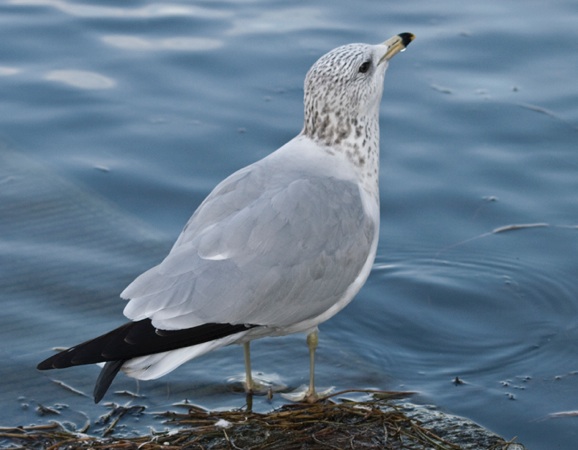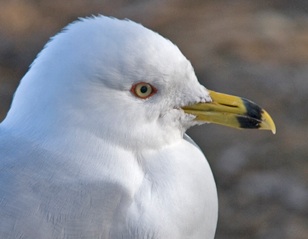A practical guide to bird watching in Sonoma County, California
(Unless otherwise indicated, all phone numbers are in the 707 area code)
A practical guide to bird watching in Sonoma County, California
(Unless otherwise indicated, all phone numbers are in the 707 area code)


One of our most common gulls in the winter months. Full adults, like the bird pictured above, are not hard to identify (only Ring-billed Gull has a dark ring on a yellow bill among gulls commonly present in the county), but Ring-billed Gull takes three years to attain full adult plumage; the juvenile and intermediate stages can be confusing. Studying the books, particularly Gulls of the Americas (see below), eventually allows an awareness of patterns to emerge. Common near bodies of water inland as well as along the coast. May congregate in flooded fields.

In breeding plumage, Ring-billed Gull has a clean white head and underparts, a red orbital ring and a little red at the gape (the corner of the mouth; photos below). The bill becomes a clearer yellow, and the eye may brighten and become more yellow. The primaries are black or near-black in all plumages but adult birds normally have small white spots at the tips, visible in flight. Juvenile birds are mostly brown with a dark eye and a dark bill that may show pink at the base (the extent of the pink increases as the bird grows older until it begins to shift toward the adult pattern), and pink legs. See the usual guide books and Gulls of the Americas for the progression of plumage changes through the three years to maturity. The most similar bird we see regularly in Sonoma County is Mew Gull, which is considerably less common than Ring-billed Gull. Mew Gull (photos below) is a smaller bird that lacks the ring on the bill and has a dark iris in adult plumage.
Also see: A comparison of common gull heads in breeding and non-breeding plumages
Further reading:
Bolander and Parmeter, Birds of Sonoma County California, rev. ed., 2000, p. 62
Brinkley, National Wildlife Federation Field Guide to Birds of North America, 2007, p. 126
Dunn and Alderfer, eds., National Geographic Field Guide to the Birds of North America, 5th ed., 2006, pg. 202
Dunn and Alderfer, eds., National Geographic Field Guide to the Birds of North America, 6th ed., 2011, pg. 222
Howell and Dunn, Gulls of the Americas, 2007, pp. 39-145, 388-391
Dunne, Pete Dunne’s Essential Field Guide Companion, 2006, p. 261-262
Ehrlich, Dobkin, and Wheye, The Birder's Handbook, paperback edition, 1988, pg. 166
Fix and Bezener, Birds of Northern California, 2000, p. 174
Floyd, Smithsonian Field Guide to the Birds of North America, 2008, p. 184
Kaufman, Field Guide to Birds of North America, 2000, p. 78
Kaufman, Advanced Birding, 1990, pp. 102-108 (general notes on gull ID)
Kaufman, Field Guide to Advanced Birding, 2011, pp. 242-271 (general notes on gull ID), pp. 247-250
Lukas, Bay Area Birds: From Sonoma County to Monterey Bay, 2012, pp. 123-124
Parmeter and Wight, Birds of Sonoma County California, Update (2000-2010), 2012, p. 35
Peterson, Birds of Eastern and Central North America, 5th ed., 2002, pp. 174-175, 178.
Peterson, Field Guide to Birds of Western North America, 4th ed., 2010, p. 174, 180
Peterson, Western Birds, 3rd ed., 1990, pp. 88, 92
Sibley, Field Guide to Birds of Western North America,1st ed., 2003, p. 187
Stokes, Stokes Field Guide to the Birds of North America, 1st ed., 2010, p. 312-313
Vuilleumier, American Museum of Natural History, Birds of North America: Western Region, 2011, p. 166
Voice: Cornell Lab of Ornithology: All About Birds--Ring-billed Gull
© Colin Talcroft, 2009, 2010, 2011, 2012, 2013
Unless noted, all photos by the author. If you would like to use one of my images, please ask for permission for non-commercial use with proper credit or commercial use with proper compensation.
Adult Ring-billed Gull: Winter plumage, but beginning to show hint of red orbital ring of breeding plumage above the eye; pale iris; comparatively straight, light bill; black ring on bill; streaked head typical of winter birds


Adult Ring-billed Gull: Winter plumage, but moving into breeding plumage; Note especially the full red orbital ring, more red at corner of mouth, and brighter yellow bill compared with the bird at left

First-cycle Ring-billed Gull: As the bird ages, bill color, eye color, leg color, and body plumage will all change (some of the grey adult back feathers have already come in on this bird)

Adult Ring-billed Gull, winter plumage: The bill ring is often visible in flight. Note the distinct black wing tips with comparatively small white spots--note also how deceptive shadows can be

For comparison: Adult Mew Gull: Winter plumage. Note: Small, comparatively straight bill; Lack of ring; dark iris; more and browner streaking on the head

For comparison: At left: Adult Mew Gull, winter plumage. At right: Adult Ring-billed Gull, winter plumage
Ring-billed Gull is larger, has a pale iris, has the ringed bill, a larger bill, proportionately longer legs,and different pattern of spotting on head and neck. Lake Ralphine, December 14, 2011

Adult Ring-billed Gull, winter plumage. This bird is unusual, as it shows no white spots on the primaries.
Lake Ralphine, December 14, 2011
Ring-billed Gull, Full breeding plumage
Lake Ralphine, Santa Rosa, March 12, 2012

Ring-billed Gull
Larus delawarensis
1990-2013 Sonoma County data. Graph provided by eBird (www.ebird.org), generated August 4, 2013
EBird-reported occurrence in Sonoma County


Adult Ring-billed Gull: Breeding plumage, Lake Ralphine, Santa Rosa, March 12, 2012